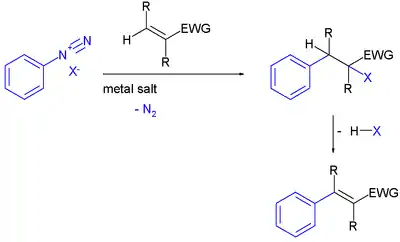| Meerwein arylation | |
|---|---|
| Named after | Hans Meerwein |
| Reaction type | Coupling reaction |
The Meerwein arylation is an organic reaction involving the addition of an aryl diazonium salt (ArN2X) to an electron-poor alkene usually supported by a metal salt.[1] The reaction product is an alkylated arene compound. The reaction is named after Hans Meerwein, one of its inventors who first published it in 1939.

An electron-withdrawing group (EWG) on the alkene makes it electron deficient and although the reaction mechanism is unclear,[2] involvement of an aryl radical is presumed after loss of nitrogen in the diazonium salt followed by a free radical addition. In the primary reaction product the intermediate alkyl radical is then captured by the diazonium counterion X which is usually a halogen or a tetrafluoroborate. In a subsequent step an elimination reaction liberates HX (for instance hydrochloric acid) and an aryl vinyl compound is formed. The reaction mechanism from the arene's view ranks as a radical-nucleophilic aromatic substitution.
In a general scope a Meerwein arylation is any reaction between an aryl radical and an alkene.[3] The initial intermediate is an aryl enthenyl radical which can react with many trapping reagents such as hydrogen or halogens or with those based on nitrogen or sulfur.
Scope
A reported reaction of alkene acrylic acid with an aryl diazonium salt and copper(I) bromide and hydrobromic acid yields the α-bromocarboxylic acid.[4] When the alkene is butadiene the initial reaction product with catalyst copper(II) chloride is a 4-chloro-2-butene and after an elimination the aryl substituted butadiene.[5] In a so-called reductive arylation with 3-buten-2-one, titanium trichloride reduces the newly formed double bond.[6]
In a novel kilogram-scale metal-free Meerwein arylation the diazonium salt is formed from 2-nitroaniline, the alkene isopropenyl acetate is an adduct of propyne and acetic acid and the reaction product 2-nitrophenylacetone:[7]

See also
- Roskamp reaction – also sees substitution of a diazonium compound by a carbon centre
- Heck-Matsuda reaction – palladium catalysed version
References
- ↑ Meerwein, Hans; Buchner, Eberhard; van Emster, Konrad (1939). "Über die Einwirkung aromatischer Diazoverbindungen auf α,β-ungesättigte Carbonylverbindungen". J. Prakt. Chem. (in German). 152 (7–10): 237–266. doi:10.1002/prac.19391520705.
- ↑ Kürti, Laszlo; Czakó, Barbara (2005). Strategic Applications of Named Reactions in Organic Synthesis: Background and Detailed Mechanisms. Elsevier Academic Press. ISBN 9780124297852.
- ↑ Heinrich, Markus R. (2009). "Intermolecular Olefin Functionalisation Involving Aryl Radicals Generated from Arenediazonium Salts". Chem. Eur. J. 15 (4): 820–833. doi:10.1002/chem.200801306. PMID 19086045.
- ↑ Cleland, George H. (1971). "p-Acetyl-α-bromohydrocinnamic Acid (Benzenepropanoic acid, 4-acetyl-α-bromo-)". Organic Syntheses. 51: 1. doi:10.15227/orgsyn.051.0001.; Collective Volume, vol. 6, p. 21
- ↑ Ropp, Gus A.; Coyner, Eugene C. (1951). "1-(p-Nitrophenyl)-1,3-butadiene". Organic Syntheses. 31: 80. doi:10.15227/orgsyn.031.0080.; Collective Volume, vol. 4, p. 727
- ↑ Citterio, Attilio (1984). "Reductive Arylation of Electron-Deficient Olefins: 4-(4-Chlorophenyl)butan-2-one". Organic Syntheses. 62: 67. doi:10.15227/orgsyn.062.0067.; Collective Volume, vol. 7, p. 105
- ↑ Molinaro, Carmela; Mowat, Jeffrey; Gosselin, Francis; O'Shea, Paul D.; Marcoux, Jean-François; Angelaud, Rémy; Davies, Ian W. (2007). "A Practical Synthesis of α-Aryl Methyl Ketones via a Transition-Metal-Free Meerwein Arylation". J. Org. Chem. 72 (5): 1856–1858. doi:10.1021/jo062483g. PMID 17263583.